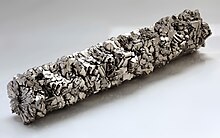 Type: Periodic Element
Type: Periodic Element
Periodic Element: (Ti)
RDA: None
Importance- To Body:
Does not play any natural role inside the human body
Distribution- In Body:
An estimated quantity of 0.8 milligrams of titanium is ingested by humans each day, but most passes through without being absorbed into tissues.
Excess Effects:
Non-toxic even in large doses.
Deficiency Effects:
None listed
Sources Food:
None listed
Sources Environmental/Geographic:
Titanium is the ninth-most abundant element in Earth’s crust (0.63% by mass) and the seventh-most abundant metal. It is present as oxides in most igneous rocks, in sediments derived from them, in living things, and natural bodies of water. Significant titanium-bearing ilmenite deposits exist in western Australia, Canada, China, India, Mozambique, New Zealand, Norway, Sierra Leone, South Africa, and Ukraine.
Titanium dioxide nanoparticles are widely used in electronics and the delivery of pharmaceuticals and cosmetics.
Supplemental information:
Because titanium is biocompatible (non-toxic and not rejected by the body), it has many medical uses, including surgical implements and implants, such as hip balls and sockets (joint replacement) and dental implants that can stay in place for up to 20 years.[40] The titanium is often alloyed with about 4% aluminium or 6% Al and 4% vanadium.
The fungal species Marasmius oreades and Hypholoma capnoides can bioconvert titanium in titanium polluted soils.
< br/>
 |
||||||||||||||||||||||||||||||||||||||
| General properties | ||||||||||||||||||||||||||||||||||||||
|---|---|---|---|---|---|---|---|---|---|---|---|---|---|---|---|---|---|---|---|---|---|---|---|---|---|---|---|---|---|---|---|---|---|---|---|---|---|---|
| Pronunciation | /tɪˈteɪniəm, taɪ-/ |
|||||||||||||||||||||||||||||||||||||
| Appearance | silvery grey-white metallic | |||||||||||||||||||||||||||||||||||||
| Standard atomic weight (Ar, standard) | 47.867(1) | |||||||||||||||||||||||||||||||||||||
| Titanium in the periodic table | ||||||||||||||||||||||||||||||||||||||
|
||||||||||||||||||||||||||||||||||||||
| Atomic number (Z) | 22 | |||||||||||||||||||||||||||||||||||||
| Group | group 4 | |||||||||||||||||||||||||||||||||||||
| Period | period 4 | |||||||||||||||||||||||||||||||||||||
| Element category | transition metal | |||||||||||||||||||||||||||||||||||||
| Block | d-block | |||||||||||||||||||||||||||||||||||||
| Electron configuration | [Ar] 3d2 4s2 | |||||||||||||||||||||||||||||||||||||
|
Electrons per shell
|
2, 8, 10, 2 | |||||||||||||||||||||||||||||||||||||
| Physical properties | ||||||||||||||||||||||||||||||||||||||
| Phase at STP | solid | |||||||||||||||||||||||||||||||||||||
| Melting point | 1941 K (1668 °C, 3034 °F) | |||||||||||||||||||||||||||||||||||||
| Boiling point | 3560 K (3287 °C, 5949 °F) | |||||||||||||||||||||||||||||||||||||
| Density (near r.t.) | 4.506 g/cm3 | |||||||||||||||||||||||||||||||||||||
| when liquid (at m.p.) | 4.11 g/cm3 | |||||||||||||||||||||||||||||||||||||
| Heat of fusion | 14.15 kJ/mol | |||||||||||||||||||||||||||||||||||||
| Heat of vaporization | 425 kJ/mol | |||||||||||||||||||||||||||||||||||||
| Molar heat capacity | 25.060 J/(mol·K) | |||||||||||||||||||||||||||||||||||||
Vapor pressure
|
||||||||||||||||||||||||||||||||||||||
| Atomic properties | ||||||||||||||||||||||||||||||||||||||
| Oxidation states | 4, 3, 2, 1, −1, −2 |
|||||||||||||||||||||||||||||||||||||
| Electronegativity | Pauling scale: 1.54 | |||||||||||||||||||||||||||||||||||||
| Ionization energies |
|
|||||||||||||||||||||||||||||||||||||
| Atomic radius | empirical: 147 pm | |||||||||||||||||||||||||||||||||||||
| Covalent radius | 160±8 pm | |||||||||||||||||||||||||||||||||||||
|
||||||||||||||||||||||||||||||||||||||
| Miscellanea | ||||||||||||||||||||||||||||||||||||||
| Crystal structure | hexagonal close-packed (hcp) | |||||||||||||||||||||||||||||||||||||
| Speed of sound thin rod | 5090 m/s (at r.t.) | |||||||||||||||||||||||||||||||||||||
| Thermal expansion | 8.6 µm/(m·K) (at 25 °C) | |||||||||||||||||||||||||||||||||||||
| Thermal conductivity | 21.9 W/(m·K) | |||||||||||||||||||||||||||||||||||||
| Electrical resistivity | 420 nΩ·m (at 20 °C) | |||||||||||||||||||||||||||||||||||||
| Magnetic ordering | paramagnetic | |||||||||||||||||||||||||||||||||||||
| Magnetic susceptibility | +153.0·10−6 cm3/mol (293 K) | |||||||||||||||||||||||||||||||||||||
| Young's modulus | 116 GPa | |||||||||||||||||||||||||||||||||||||
| Shear modulus | 44 GPa | |||||||||||||||||||||||||||||||||||||
| Bulk modulus | 110 GPa | |||||||||||||||||||||||||||||||||||||
| Poisson ratio | 0.32 | |||||||||||||||||||||||||||||||||||||
| Mohs hardness | 6.0 | |||||||||||||||||||||||||||||||||||||
| Vickers hardness | 830–3420 MPa | |||||||||||||||||||||||||||||||||||||
| Brinell hardness | 716–2770 MPa | |||||||||||||||||||||||||||||||||||||
| CAS Number | 7440-32-6 | |||||||||||||||||||||||||||||||||||||
| History | ||||||||||||||||||||||||||||||||||||||
| Discovery | William Gregor (1791) | |||||||||||||||||||||||||||||||||||||
| First isolation | Jöns Jakob Berzelius (1825) | |||||||||||||||||||||||||||||||||||||
| Named by | Martin Heinrich Klaproth (1795) | |||||||||||||||||||||||||||||||||||||
| Main isotopes of titanium | ||||||||||||||||||||||||||||||||||||||
|
||||||||||||||||||||||||||||||||||||||
Titanium is a chemical element with symbol Ti and atomic number 22. It is a lustrous transition metal with a silver color, low density, and high strength. Titanium is resistant to corrosion in sea water, aqua regia, and chlorine.
Titanium was discovered in Cornwall, Great Britain, by William Gregor in 1791, and was named by Martin Heinrich Klaproth after the Titans of Greek mythology. The element occurs within a number of mineral deposits, principally rutile and ilmenite, which are widely distributed in the Earth's crust and lithosphere, and it is found in almost all living things, water bodies, rocks, and soils. The metal is extracted from its principal mineral ores by the Kroll and Hunter processes. The most common compound, titanium dioxide, is a popular photocatalyst and is used in the manufacture of white pigments. Other compounds include titanium tetrachloride (TiCl4), a component of smoke screens and catalysts; and titanium trichloride (TiCl3), which is used as a catalyst in the production of polypropylene.
Titanium can be alloyed with iron, aluminium, vanadium, and molybdenum, among other elements, to produce strong, lightweight alloys for aerospace (jet engines, missiles, and spacecraft), military, industrial processes (chemicals and petrochemicals, desalination plants, pulp, and paper), automotive, agri-food, medical prostheses, orthopedic implants, dental and endodontic instruments and files, dental implants, sporting goods, jewelry, mobile phones, and other applications.
The two most useful properties of the metal are corrosion resistance and strength-to-density ratio, the highest of any metallic element. In its unalloyed condition, titanium is as strong as some steels, but less dense. There are two allotropic forms and five naturally occurring isotopes of this element, 46Ti through 50Ti, with 48Ti being the most abundant (73.8%). Although they have the same number of valence electrons and are in the same group in the periodic table, titanium and zirconium differ in many chemical and physical properties.


